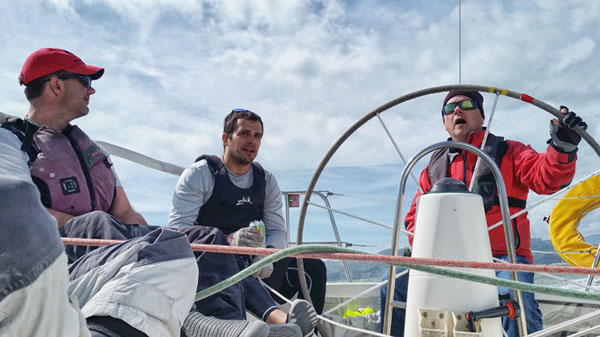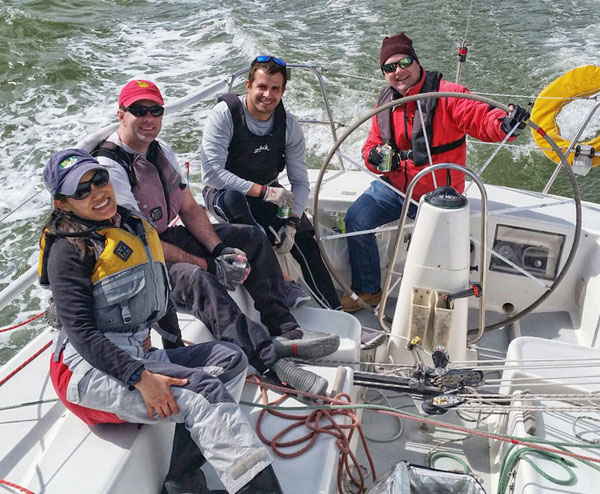
How Practices Makes Better Sailing for Crew
Practice makes better sailing, so today I’m with a new crew and old member of Fleet 1 San Francisco. Departing the protected harbor at South Beach Yacht Club, we set the sails and leisurely bobbed left to right toward the city front. JuJu is gearing up for the 2017 race season.
Sandwiches and beer–classics for sailboat racing
Normally a J/105 races with six, and it’s my duty to trim headsail and spinnaker today. Moving the fabric around on the 105 is a breeze, about the only thing to get used to is the routine of cross-boat trimming. During a tack, the headsail comes round quickly and snaps into place—allowing for enough sheet ease to permit the driver to power up—then it’s through the self-tailer and maybe one or two winch revolutions.
Since I’m the one hauling in on the new side, I pass off the line to the grinder who completes the revolutions. I then make a beeline for the high side. Practice was pretty tame, but I know that during race conditions my uphill scramble will happen over and over again.
It’s that scramble that leads to about 55 percent of a J/105 racers’ thigh and bottom bruises (30 percent more go to the shin area when bracing to haul-in the sheet on the new side, 10 percent to the knees if you kneel while pulling in the miles of newly active spinnaker sheet, and let’s say five for outer ankle bone just because it protrudes). Having mastered headsail flips, we try a few mock starts.
Better Sailing for JuJu Before Jfest
Because Fleet 1 has so many boats on the line, during a start sequence the skipper prefers to have a single trimmer stand in the cockpit with one hand on port and one on starboard jib sheet—ready to move the sail instantaneously. I tried it.
Ok, not so bad in light winds and only virtual competitors. I can see where the challenge comes with 20-30 knot blow, dodging 20+ other boats who may be mere inches aside one another, plus remembering that the line in your right hand moves the line that’s operating the sail on the left side of the boat, and vice versa. After a few average attempts at trying to nail a race start line, we next play with the big fabric.
The J/105 solely taps an asymmetric, so in theory there are not too many foul-up scenarios. Skipper voiced his concerns to be 1) not hoisting the spinnaker fast enough, and 2) chute going up with a twist. We avoided both during practice, and only had a few slow sets on race day number two due to fatigue and building winds.
Having not trimmed a 105 spinnaker in a few years, I had to find again that sweet spot re: number of wraps required on the barrel—one or two—and when to alert a winch trimmer. Seems 16-knots and higher in San Francisco Bay required two wraps. Eventually we three (pit, bow and myself) find the ballet and all is keen.
Read about San Francisco’s competitive J/1-5 Fleet 1. Fleet #1 is the biggest, longest-running and most competitive J/105 fleet in the world, so states the website. These crews know that practice makes better sailing.
J/105 Boat Snapshot
Introduced in 1991 as the first modern day keelboat with bow-sprit and asymmetric spinnaker, J/105 today is the most successful one-design keelboat class over 30′ in the USA with over 680 boats sailing worldwide. The class association is an owner managed organization with strict one-design rules, a world class web site, and offers the best and most active one-design racing in the USA today.
The class rules include an owner-driver rule, tight restrictions on Category 3 professionals, and annual sail purchase restrictions to keep racing affordable and as Corinthian as modern one-design can be.
